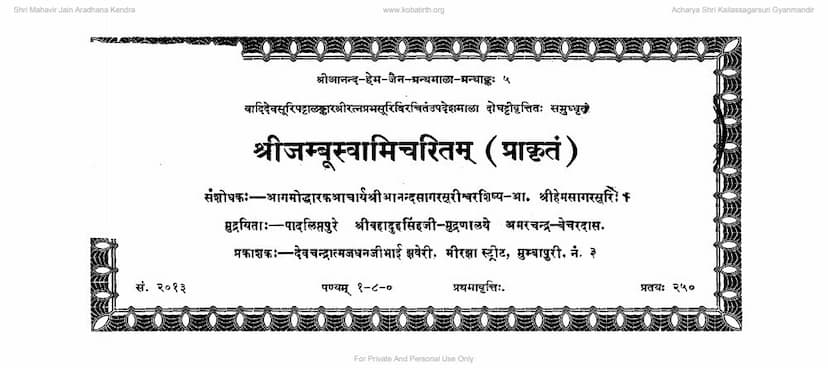Jambuswami Charitam
Added to library: September 2, 2025

Summary
This document is the "Jambuswami Charitam," a Jain text attributed to Ratnaprabhsuri and Hemsagarsuri, published by Dhanjibhai D. Zaveri. It is the fifth book in the Shri Anand-Hem-Jain-Granthmala series. The text is in Prakrit and is presented as an excerpt from a commentary on "Upadeshamala" by Vadidevsuri.
The "Jambuswami Charitam" narrates the life story and spiritual journey of Jambuswami, a principal disciple of Lord Mahavir. The text details his spiritual evolution through various lifetimes, highlighting key events and philosophical teachings.
Here's a breakdown of the content based on the provided pages:
Key Themes and Narratives:
- The Life of Jambuswami: The text chronicles the journey of Jambuswami, from his birth in the Magadha region to his spiritual enlightenment. It emphasizes his devotion, adherence to vows, and ultimate attainment of liberation (moksha).
- Past Lives and Karma: A significant portion of the text is dedicated to illustrating the concept of karma and its impact across multiple lifetimes. Jambuswami's spiritual progress is shown through various births, demonstrating how past actions influence present circumstances and future destinies.
- Moral Exemplars and Ethical Teachings: The "Jambuswami Charitam" is replete with stories of various individuals and their experiences, serving as moral exemplars. These narratives illustrate Jain ethical principles such as non-violence (ahimsa), truthfulness (satya), non-stealing (asteya), celibacy (brahmacharya), and non-possession (aparigraha).
- The Role of Gurus and Disciples: The text emphasizes the importance of a spiritual preceptor (guru) in guiding disciples towards the right path. The interactions between Jambuswami and his gurus, as well as the guidance provided to others, highlight the master-disciple relationship.
- Illustrative Tales (Drishtantas): The text employs numerous illustrative stories (drishtantas) to explain complex philosophical concepts in an accessible manner. These stories often involve allegorical characters and situations that convey moral and spiritual lessons. Some of the prominent narratives and examples include:
- The story of Bhavadatta and Bhavadeva: This narrative illustrates the consequences of attachment and the path to renunciation.
- The story of Nagila: This tale highlights the importance of righteous conduct and the pursuit of spiritual merit.
- The story of Madhubindu: This parable serves as a cautionary tale about the dangers of attachment and the fleeting nature of worldly pleasures, emphasizing the pursuit of true liberation.
- The story of Kuverdatta and Kuverdattā: This narrative explores complex relationships, past karma, and the consequences of actions, even within familial bonds.
- The story of Maheshwaradatta: This story emphasizes the importance of understanding the ethical implications of actions, particularly regarding compassion and non-violence.
- The story of the Monkey Couple: This tale illustrates the folly of excessive desire and attachment, even in the face of spiritual guidance.
- The story of the Greedy Merchant and the Magic Cow: This narrative underscores the destructive nature of greed and the illusory nature of worldly wealth.
- The story of the Three Friends: This story highlights the importance of true friendship and loyalty in navigating life's challenges.
- The story of the Monkey and the Gems: This story illustrates the destructive consequences of avarice and the folly of seeking worldly gains through unethical means.
- The story of the Courtesan Lohamgala: This extensive narrative delves into the moral degradation caused by greed and attachment, showcasing the illusory nature of worldly relationships and the eventual downfall of those who pursue them.
- The story of Prabhakar: This narrative emphasizes the importance of renunciation and spiritual guidance in overcoming worldly attachments and achieving true happiness.
- The story of Vijaya and Sujaya: This tale illustrates the consequences of family disputes and the importance of righteous conduct and spiritual seeking.
- The story of the Yogaraja and the Corrupt Kingdom: This narrative critiques the corrupt administration of a kingdom and highlights the importance of justice and ethical governance.
- The story of the Irsyalusthavira (Envious Elder Monk): This tale illustrates the detrimental effects of envy and the importance of humility in spiritual practice.
- The story of Amarasan and Pravarasan: This narrative explores themes of familial bonds, worldly ambitions, and the ultimate realization of spiritual truths.
Overall Purpose:
The "Jambuswami Charitam" serves as a guide for spiritual aspirants, reinforcing Jain principles through compelling narratives and illustrating the path to liberation. It emphasizes the transformative power of righteous actions, the consequences of karma, and the importance of spiritual discipline and detachment from worldly affairs. The text aims to inspire readers to follow the path of Jainism, leading to spiritual growth and ultimate salvation.